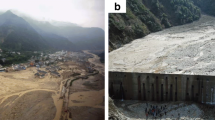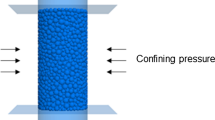Abstract
Lahars (volcanic debris flows) are natural phenomena that can generate severe damage and wreak havoc in densely populated urban areas. The evaluation of the forces and pressures generated by these mass flows on constructions (e.g., buildings, bridges and other infrastructure) is crucial for civil protection, assessment of physical vulnerability and risk management. The current tools developed to model the spread of flows at large scale in densely populated urban areas remain inaccurate in the evaluation of mechanical efforts. Here, we developed a discrete numerical model for evaluating debris-flow (DF) impact forces at the local scale of one structure (pillar or column) like a building, a bridge and other infrastructure. In this model, the large-sized solid particles that damage infrastructures and edifices are explicitly modelled using Distinct Element Method (DEM). We considered the fluid and fine-grained solid particles not only in the frame of the pressure exerted on structures, but also through their effects on the movement of particles, i.e. buoyancy and drag. The fluid velocity field and the fluid free surface obtained from Computational Fluid Dynamics (CFD) calculation based on Navier–Stokes equations are imported in the DEM simulation. This model is able to reproduce a range of magnitudes of DFs in terms of volumes, velocities and flow heights. Finally, the model provides insights on impact forces generated by particles on structures and on hydrostatic and/or dynamic pressure due to the combined effect of fluid and solid phases. The model provides results consistent with existing empirical models.












Similar content being viewed by others
Change history
18 June 2021
A Correction to this paper has been published: https://doi.org/10.1007/s10064-021-02310-6
References
Albaba A, Lambert S, Nicot F, Chareyre B (2015) Relation between microstructure and loading applied by granular flow to a rigid wall using DEM modeling. Granular Matter 17:603–616. https://doi.org/10.1007/s10035-015-0579-8
Albaba A, Schwarz M, Wendeler C, Loup B, Dorren L (2019) Numerical modeling using an elastoplastic-adhesive discrete element code for simulating hillslope debris flows and calibration against field experiments. Nat Hazard 19(11):2339–2358. https://doi.org/10.5194/nhess-19-2339-2019
Bugnion L, McArdell BW, Bartelt P, Wendeler C (2012) Measurements of hillslope debris flow impact pressure on pillars. Landslides 9(2):179–187. https://doi.org/10.1007/s10346-011-0294-4
Cheng YM, Li N, Fung IWH (2018) Laboratory and field test and distinct element analysis of debris flow. Nat Hazards Earth Syst Sci Discussions 1–32. https://doi.org/10.5194/nhess-2018-36
Cui P, Zeng C, Lei Y (2015) Experimental analysis on the impact force of viscous debris flow. Earth Surf Proc Land 40(12):1644–1655. https://doi.org/10.1002/esp.3744
Cundall PA, Strack ODL (1979) A discrete numerical model for granular assemblies. Géotechnique 29(1):47–65. https://doi.org/10.1680/geot.1979.29.1.47
Dai Z, Huang Y, Cheng H, Xu Q (2017) SPH model for fluid–structure interaction and its application to debris flow impact estimation. Landslides 14(3):917–928. https://doi.org/10.1007/s10346-016-0777-4
Doyle EE, Cronin SJ, Cole SE, Thouret JC (2010) The coalescence and organization of lahars at Semeru volcano. Indonesia Bull Volcanol 72:961–970. https://doi.org/10.1007/s00445-010-0381-8
Doyle EE, Cronin SJ, Thouret JC (2011) Defining conditions for bulking and debulking lahars. Geol Soc Am Bull 123(7–8):1234–1247. https://doi.org/10.1130/B30227.1
Ettinger S, Mounaud L, Magill C, Yao-Lafourcade AF, Thouret JC, Manville V, Negulescu C, Zuccaro G, De Gregorio D, Nardone S, Uchuchoque JAL, Arguedas A, Macedo L, Manrique Llerena N (2015) Building vulnerability to hydrogeomorphic hazards: estimating damage probability from qualitative vulnerability assessment using logistic regression. J Hydrol 541:563–581. https://doi.org/10.1016/j.jhydrol.2015.04.017
Federico F, Amoruso A (2008) Simulation of mechanical effects due to the impact of fluid-like debris flows on structures. Ital J Eng Geol Environ 8(1):5–24. https://doi.org/10.4408/IJEGE.2008-01.O-01
Furtney J, Zhang F, Han Y (2013) Review of methods and applications for incorporating fluid flow in the Discrete Element Method. In: Proceedings of the 5th International FLAC/DEM Symposium. Itasca International Inc. (Minneapolis, MN), Hangzhou, P.R. China, 10 p
He X, Liang D, Wu W, Cai G, Zhao C, Wang S (2018) Study of the interaction between dry granular flows and rigid barriers with an SPH model. Int J Numer Anal Meth Geomech 42(11):1217–1234. https://doi.org/10.1002/nag.2782
Hu K, Wei F, Li Y (2011) Real-time measurement and preliminary analysis of debris-flow impact force at Jiangjia Ravine, China. Earth Surf Process Landf 36:1268–1278. https://doi.org/10.1002/esp.2155
Hübl J, Suda J, Proske D, Kaitna R, Scheidl C (2009) Debris flow impact estimation. In: Proceedings of the 11th International Symposium on Water Management and Hydraulic Engineering, Ohrid (North Macedonia) (1–5 September) 137–148
Hübl J, Suda J, Nagl G, Rudolf-Miklau F (2017) Standardized stress model for design of torrential barriers under impact by debris flow (according to Austrian Standard Regulation 24801). Int J Eros Control Eng 10(1):47–55. https://doi.org/10.13101/ijece.10.47
Itasca (2016) Particle Flow Code 5.0 Documentation
Iverson RM, Costa JE, LaHusen RG (1992) Debris-flow flume at H.J. Andrews Experimental Forest, Oregon. U.S. Geological Survey, Open-file Report 92–483. https://doi.org/10.3133/ofr92483
Iverson RM (1997) The physics of debris flows. Rev Geophys 35(3):245–296. https://doi.org/10.1029/97RG00426
Iverson RM, Logan M, LaHusen RG, Berti M (2010) The perfect debris flow? Aggregated results from 28 large-scale experiments. J Geophys Res 115(F03005):29. https://doi.org/10.1029/2009JF001514
Iverson RM, George DL (2014) A depth-averaged debris-flow model that includes the effects of evolving dilatancy. I. Physical basis. Proceedings of the Royal Society A 470: 20130819. https://doi.org/10.1098/rspa.2013.0819
Kattel P, Kafle J, Fischer JT, Mergili M, Tuladhar BM, Pudasaini SP (2018) Interaction of two-phase debris flow with pillars. Eng Geol 242:197–217. https://doi.org/10.1016/j.enggeo.2018.05.023
Lavigne F, Thouret JC (2000) Les lahars : dépôts, origines et dynamiques. Bulletin De La Société Géologique De France 1741(5):545–557. https://doi.org/10.2113/171.5.545
Leonardi A, Wittel FK, Mendoza M, Vetter R, Herrmann HJ (2016) Particle-fluid-structure interaction for debris flow impact on flexible barriers. Comput-Aided Civ Inf Eng 31(5):323–333. https://doi.org/10.1111/mice.12165
Li X, Zhao J (2018) A Unified CFD-DEM approach for modeling of debris flow impacts on flexible barriers. Int J Numer Anal Meth Geomech 42:1643–1670. https://doi.org/10.1002/nag.2806
Liu C, Sun Q, Zhou GGD (2018) Coupling of material point method and discrete element method for granular flows impacting simulations. Int J Numer Methods Eng 115:172–188. https://doi.org/10.1002/nme.5800
Major JJ (1995) Experimental studies of deposition at a debris-flow flume. U.S. Geolocial Survey, Fact sheet 028–94. https://doi.org/10.3133/fs02894
Major JJ, Bertin D, Pierson TC, Amigo A, Iroume A, Ulloa H, Castro J (2016) Extraordinary sediment delivery and rapid geomorphic response following the 2008–2009 eruption of Chaiten Volcano, Chile. Water Resour Res 52:5075–5094. https://doi.org/10.1002/2015WR018250
Manville V, Major JJ, Fagents SA (2013) Modeling lahar behavior and hazards. In: Fagents SA, Gregg TKP, Lopes RMC (Eds) Modeling volcanic processes: the physics and mathematics of volcanism, chapter 14. Cambridge University Press, Cambridge, pp. 300–330. https://doi.org/10.1017/CBO9781139021562.014
Mead SR, Magill C, Lemiale V, Thouret JC, Prakash M (2017) Examining the impact of lahars on buildings using numerical modeling. Nat Hazard 17:703–719. https://doi.org/10.5194/nhess-17-703-2017
Moulinec C, Denis C, Pham C et al (2011) TELEMAC: an efficient hydrodynamics suite for massively parallel architectures Q. Comput Fluids 51:30–34
Newhall CG, Punongbayan RS (1996) Fire and mud: eruptions and lahars of Mount Pinatubo. University of Washington Press, Seattle, Philippines
Paguican EMR, Lagmay AMF, Rodolfo KS, Rodolfo RS, Tengonciang AMP, Lapus MR, Baliatan EG, Obille EC Jr (2009) Extreme rainfall-induced lahars and dike breaching, 30 November 2006, Mayon Volcano. Philippines Bull Volcanol 71(8):845–857. https://doi.org/10.1007/s00445-009-0268-8
Pallares C, Fabre D, Thouret JC, Bacconnet C, Charca-Chura JA, Martelli K, Talon A, Yanqui-Murillo C (2015) Geological and geotechnical characteristics of recent lahar deposits from El Misti volcano in the city area of Arequipa. South Peru Geotech Geol Eng 33(3):641–660. https://doi.org/10.1007/s10706-015-9848-x
Proske D, Suda J, Hübl J (2011) Debris flow impact estimation for breakers. Georisk 5(2):143–155
Pudasaini SP (2012) A general two-phase debris flow model J Geophys Res Earth Surf 117 https://doi.org/10.1029/2011JF002186
Rameshwaran P, Naden P et al (2013) Inter-comparison and validation of computational fluid dynamics codes in two-stage meandering channel flows. Appl Math Model 37(20–21):8652–8672. https://doi.org/10.1016/j.apm.2013.07.016
Scott KM, Vallance JW, Kerle N, Macias JL, Strauch W, Devoli G (2005) Catastrophic precipitation-triggered lahar at Casita volcano, Nicaragua: occurrence, bulking and transformation. Earth Surf Proc Land 30:59–79. https://doi.org/10.1002/esp.1127
Scheidl C, Chiari M, Kaitna R, Müllegger M, Krawtschuk A, Zimmermann T, Proske D (2013) Analysing debris-flow impact models, based on a small scale modelling approach. Surv Geophys 34:121–140. https://doi.org/10.1007/s10712-012-9199-6
Smith GA (1986) Coarse-grained nonmarine volcaniclastic sediment: terminology and depositional process. Geol Soc Am Bull 97(1):1–10
Sosio R, Crosta GB, Frattini P (2007) Field observations, rheological testing and numerical modelling of a debris-flow event. Earth Surf Proc Land 32(2):290–306
Teufelsbauer H, Wang Y, Pudasaini SP, Borja RI, Wu W (2011) DEM simulation of impact force exerted by granular flow on rigid structures. Acta Geotech 6:119–133. https://doi.org/10.1007/s11440-011-0140-9
Tiberghien D, Laigle D, Naaim M, Thibert E, Ousset F (2007) Experimental investigations of interaction between mudflow and an obstacle. In: Proceedings of the Fourth International Conference on Debris-Flow Hazards Mitigation: Mechanics, Prediction, and Assessment (DFHM-4), Chengdu (China) (September 10-13) 281–292
Thouret JC, Enjolras G, Martelli K, Santoni O, Luque JA, Nagata M, Argedas A, Macedo L (2013) Combining criteria for delineating lahar- and flash flood-prone hazard and risk zones for the city of Arequipa, Peru. Nat Hazard 13(2):339–360. https://doi.org/10.5194/nhess-13-339-2013
Thouret JC, Ettinger S, Guitton M, Santoni O, Magill C, Martelli K, Arguedas A (2014) Assessing physical vulnerability in large cities exposed to flash floods and debris flows: the case of Arequipa (Peru). Nat Hazards 73(3):1771–1815. https://doi.org/10.1007/s11069-014-1172-x
Thouret JC, Antoine S, Magill C, Ollier C (2020) Lahars and debris flows: characteristics and impacts Earth Sci Rev 201 https://doi.org/10.1016/j.earscirev.2019.103003
Toyos G, Gunasekera R, Zanchetta G, Oppenheimer C, Sulpizio R, Favalli M, Pareschi MT (2008) GIS‐assisted modelling for debris flow hazard assessment based on the events of May 1998 in the area of Sarno, Southern Italy: II. Velocity and dynamic pressure. Earth Surface Processes and Landforms: J British Geomorphological Res Group 33(11):1693–1708
Trujillo-Vela MG, Galindo-Torres SA, Zhang X, Ramos-Cañón AM, Escobar-Vargas JA (2020) Smooth particle hydrodynamics and discrete element method coupling scheme for the simulation of debris flows. Comput Geotech 125:103669
Vallance JW (2000) Lahars. In: Sigurdsson H, Houghton BF, McNutt SR, Rymer H, Stix J (eds) Encyclopedia of volcanoes. Academic Press, San Diego, pp 601–616
Vallance JW, Iverson R et al (2015) Lahars and their deposits. In: Sigurdsson H (ed) The Encyclopedia of Volcanoes, 2nd edn. Academic Press, San Diego, pp 649–664
Wang D, Chen Z, He S, Liu Y, Tang H (2018) Measuring and estimating the impact pressure of debris flows on bridge piers based on large-scale laboratory experiments. Landslides 15(7):1331–1345. https://doi.org/10.1007/s10346-018-0944-x
Zanchetta G, Sulpizio R, Pareschi MT, Leoni FM, Santacroce R (2004) Characteristics of May 5–6, 1998 volcaniclastic debris flows in the Sarno area (Campania, southern Italy): relationships to structural damage and hazard zonation. J Volcanol Geoth Res 133:377–393. https://doi.org/10.1016/S0377-0273(03)00409-8
Zhang S (1993) A comprehensive approach to the observation and prevention of debris flows in China. Nat Hazards 7:1–23. https://doi.org/10.1007/BF00595676
Zhao T, Houlsby GT, Utili S (2014) Investigation of granular batch sedimentation via DEM–CFD coupling. Granular Matter 16(6):921–932
Zhao L, He JW, Yu ZX, Liu YP, Zhou ZH, Chan SL (2020) Coupled numerical simulation of a flexible barrier impacted by debris flow with boulders in front. Landslides 17:2723–2736. https://doi.org/10.1007/s10346-020-01463-x
Acknowledgements
The authors thank the Municipality of Arequipa, the Arequipa Civil Defence and the Department of Geology of the University Nacional San Agustin in Arequipa. This work was supported by the Pack Ambition Recherche project QUoRUM from the Région Auvergne Rhône-Alpes (RC, BC, PB). JCT acknowledges the support received from the Agence Nationale de la Recherche of the French government through the program "Investissements d’Avenir" (16-IDEX-0001 CAP 20-25).
Author information
Authors and Affiliations
Corresponding author
Additional information
The original online version of this article was revised: The authors would like to update Figure 5. The notation of the subscript of letter \rho is not displayed correctly: it should display \rho_{Mu} the subscript {Mu} does not appear as it should in the Figure.
Rights and permissions
About this article
Cite this article
Chehade, R., Chevalier, B., Dedecker, F. et al. Discrete modelling of debris flows for evaluating impacts on structures. Bull Eng Geol Environ 80, 6629–6645 (2021). https://doi.org/10.1007/s10064-021-02278-3
Received:
Accepted:
Published:
Issue Date:
DOI: https://doi.org/10.1007/s10064-021-02278-3




